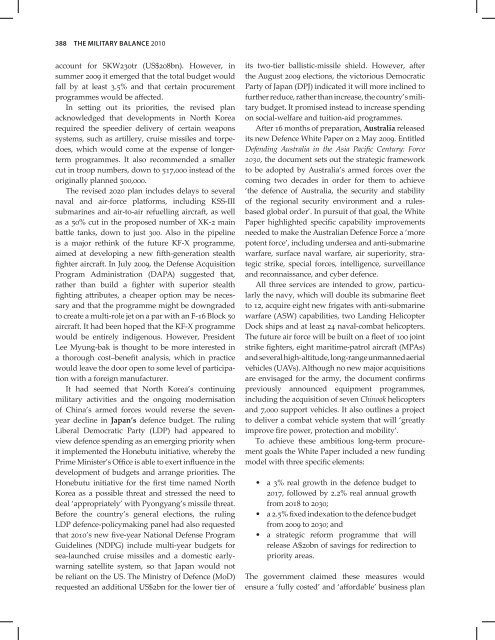You also want an ePaper? Increase the reach of your titles
YUMPU automatically turns print PDFs into web optimized ePapers that Google loves.
388 THE MILITARY BALANCE 2010<br />
account for SKW���tr (US$���bn). However, in<br />
summer ���� it emerged that the total budget would<br />
fall by at least �.�% and that certain procurement<br />
programmes would be affected.<br />
In se�ing out its priorities, the revised plan<br />
acknowledged that developments in North Korea<br />
required the speedier delivery of certain weapons<br />
systems, such as artillery, cruise missiles and torpedoes,<br />
which would come at the expense of longerterm<br />
programmes. It also recommended a smaller<br />
cut in troop numbers, down to ���,��� instead of the<br />
originally planned ���,���.<br />
The revised ���� plan includes delays to several<br />
naval and air-force platforms, including KSS-III<br />
submarines and air-to-air refuelling aircraft, as well<br />
as a ��% cut in the proposed number of XK-� main<br />
ba�le tanks, down to just ���. Also in the pipeline<br />
is a major rethink of the future KF-X programme,<br />
aimed at developing a new fifth-generation stealth<br />
fighter aircraft. In July ����, the Defense Acquisition<br />
Program Administration (DAPA) suggested that,<br />
rather than build a fighter with superior stealth<br />
fighting a�ributes, a cheaper option may be necessary<br />
and that the programme might be downgraded<br />
to create a multi-role jet on a par with an F-�� Block ��<br />
aircraft. It had been hoped that the KF-X programme<br />
would be entirely indigenous. However, President<br />
Lee Myung-bak is thought to be more interested in<br />
a thorough cost–benefit analysis, which in practice<br />
would leave the door open to some level of participation<br />
with a foreign manufacturer.<br />
It had seemed that North Korea’s continuing<br />
military activities and the ongoing modernisation<br />
of China’s armed forces would reverse the sevenyear<br />
decline in Japan’s defence budget. The ruling<br />
Liberal Democratic Party (LDP) had appeared to<br />
view defence spending as an emerging priority when<br />
it implemented the Honebutu initiative, whereby the<br />
Prime Minister’s Office is able to exert influence in the<br />
development of budgets and arrange priorities. The<br />
Honebutu initiative for the first time named North<br />
Korea as a possible threat and stressed the need to<br />
deal ‘appropriately’ with Pyongyang’s missile threat.<br />
Before the country’s general elections, the ruling<br />
LDP defence-policymaking panel had also requested<br />
that ����’s new five-year National Defense Program<br />
Guidelines (NDPG) include multi-year budgets for<br />
sea-launched cruise missiles and a domestic earlywarning<br />
satellite system, so that Japan would not<br />
be reliant on the US. The Ministry of Defence (MoD)<br />
requested an additional US$�bn for the lower tier of<br />
its two-tier ballistic-missile shield. However, after<br />
the August ���� elections, the victorious Democratic<br />
Party of Japan (DPJ) indicated it will more inclined to<br />
further reduce, rather than increase, the country’s military<br />
budget. It promised instead to increase spending<br />
on social-welfare and tuition-aid programmes.<br />
After �� months of preparation, Australia released<br />
its new Defence White Paper on � May ����. Entitled<br />
Defending Australia in the Asia Pacific Century: Force<br />
����, the document sets out the strategic framework<br />
to be adopted by Australia’s armed forces over the<br />
coming two decades in order for them to achieve<br />
‘the defence of Australia, the security and stability<br />
of the regional security environment and a rulesbased<br />
global order’. In pursuit of that goal, the White<br />
Paper highlighted specific capability improvements<br />
needed to make the Australian Defence Force a ‘more<br />
potent force’, including undersea and anti-submarine<br />
warfare, surface naval warfare, air superiority, strategic<br />
strike, special forces, intelligence, surveillance<br />
and reconnaissance, and cyber defence.<br />
All three services are intended to grow, particularly<br />
the navy, which will double its submarine fleet<br />
to ��, acquire eight new frigates with anti-submarine<br />
warfare (ASW) capabilities, two Landing Helicopter<br />
Dock ships and at least �� naval-combat helicopters.<br />
The future air force will be built on a fleet of ��� joint<br />
strike fighters, eight maritime-patrol aircraft (MPAs)<br />
and several high-altitude, long-range unmanned aerial<br />
vehicles (UAVs). Although no new major acquisitions<br />
are envisaged for the army, the document confirms<br />
previously announced equipment programmes,<br />
including the acquisition of seven Chinook helicopters<br />
and �,��� support vehicles. It also outlines a project<br />
to deliver a combat vehicle system that will ‘greatly<br />
improve fire power, protection and mobility’.<br />
To achieve these ambitious long-term procurement<br />
goals the White Paper included a new funding<br />
model with three specific elements:<br />
• a �% real growth in the defence budget to<br />
����, followed by �.�% real annual growth<br />
from ���� to ����;<br />
• a �.�% fixed indexation to the defence budget<br />
from ���� to ����; and<br />
• a strategic reform programme that will<br />
release A$��bn of savings for redirection to<br />
priority areas.<br />
The government claimed these measures would<br />
ensure a ‘fully costed’ and ‘affordable’ business plan


